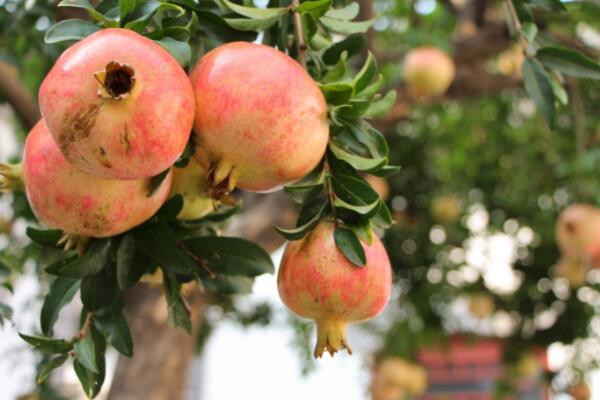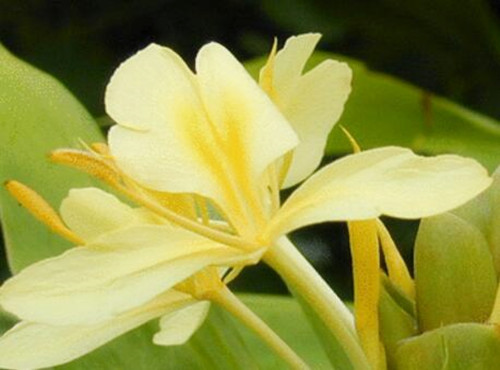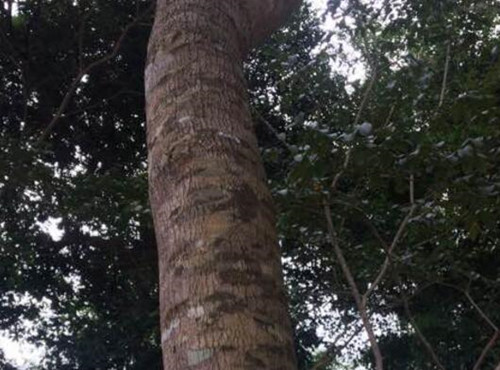What does an evergreen pomegranate tree look like? Blossom and bear fruit, long black spot, what medicine does heart-eating insect hit? How to manage maintenance?
Pomegranate is also known as pomegranate, mountain leaf, Dan Ruo, Ruo pomegranate wood, Jinlu, Jinpang, Tulin, Tianju, sweet and sour, with insecticidal, dysentery and other effects. So what does the pomegranate tree look like? Blossom and bear fruit, long black spot, what medicine does heart-eating insect hit? How to manage maintenance? According to the data of Myrtle, pomegranate is a deciduous shrub or small tree, and it is an evergreen tree in the tropics. The crown is tufted and naturally round-headed. The roots are yellowish brown. The growth is strong, and the rhizosphere is easy to root and tiller. The height of the tree can reach 5-7m, usually 3-4m, but the dwarf pomegranate is only about 1m or shorter. The trunk is grayish brown, with tuberous protuberances, and the trunk is twisted to the left.

There are many branches in the crown, and the twigs are angled and square. Twigs are flexible and not easy to break. One branch staggered opposite on a growing branchlet, with small spines. The length of thorn is related to variety and growth. A prosperous tree has many thorns, but an old tree has few thorns. The color of buds varies with the seasons, including purple, green and orange.
Leaves opposite or clustered, oblong to oblong, or elliptic-lanceolate, 2-8cm long and 1-2cm wide, apex pointed, glossy surface, abaxial midrib raised; short petiole.
Flowers bisexual, according to whether the ovary is developed or not, there are bell-shaped flowers and tubular flowers, the former ovary developed is good at fertilization results, the latter often withered unfruitful; generally 1 to several flowers born in the axils of the leaves below the top of the new shoots of the current year; sepals hard, fleshy, tubular, 5-7-lobed, connected with ovary, persistent; petals Obovate, as many as sepals and alternate, imbricate arrangement. Flowers can be divided into single and double. Double variety pistil and stamen multi-petal and sterile, petals as many as dozens of petals; flowers are more red, but also white and yellow, pink, agate and other colors. Stamens numerous, filaments glabrous. Pistil with 1 style, longer than stamens, carpels 4-8, ovary inferior. The fruit pomegranate florescence is from May to June, the pomegranate flower is like fire, and the fruit period is from September to October. Flowering period of pomegranate is from May to October.
Pomegranate trees blossom and bear fruit, black spots, heart-eating insects hit what medicine?
Blossom and bear fruit:
Spraying 300-fold boric acid or borax during the flowering period of pomegranate trees (mid-June) can increase the fruit setting rate. In addition, timely removal of too many bell flowers (lie flowers) can also improve the fruit setting rate.
Long black spots:
1. Combined with winter pruning and fertilization, we can thoroughly clean the diseased and residual branches and leaves on the ground, enter the pit for fertilizer, and reduce the stock of bacteria.
2. From late May to mid-July, there is more precipitation and the disease spreads rapidly, so we should pay attention to the sunny day and chemical control in time. The agent with better effect is 20% carbendazim sulfur suspension 500x liquid spray, which is not easy to be washed by Rain Water, and the protective effect is good. In the middle and later stage, it was protected by spraying 25% Dyson zinc with 300 times liquid of high lipid membrane.
Heart-eating insects:
1. During the unearthed stage of larvae, used 1.2% nicotine from June to July. Matrine EC 2000 times the solution sprayed around the root of the ground, spray after shallow hoe.
2. During the peak period of adults, spray 25% diflubenzuron Ⅲ suspension 3000 times or 20% diflubenzuron 4000-6000 times dilution spray to control. To kill eggs and newly hatched larvae.
3. If the insect fruit is found, it should be removed, buried or burned in time.
Other pests:
1. Pomegranate stem window moth, often check the branches and find new shoots, cut off the branches from the lower end of the last faecal hole in time to eliminate the larvae; chemical control. In the peak incubation period, Bt emulsion was sprayed on the tree with 500x liquid, and the effect was good. After the larvae have eaten into the branches, the syringe, chloramidophos and chlorpyrifos can be used to inject the liquid into the insect path, or the cotton ball can be dipped in dichlorvos and stuffed into the wormhole to seal the yellow mud and fumigate the larvae.
2. Peach borer, fruit bagging. Bagging was carried out after the pomegranate grew to the size of the thumb and the second natural fruit drop to prevent the borer moth from laying eggs on the fruit surface; chemical control. During the occurrence of adults and the peak spawning period, 10% imidacloprid 4000-6000 times or 20% diflubenzuron 4000-6000 times diluted spray.
3. Pomegranate armyworm, potted pomegranate, can be caught manually; when the number of larvae is large, it can be sprayed with 2000 times of 25% aldicarb suspension or 2500 times of 20% fenvalerate.
In mid-March, stone-sulfur mixture was used to prevent diseases and insect pests, imidacloprid was used to control aphids in May, avermectin was used to control red spiders in June, and cypermethrin was used to control heart borer and caterpillar pests from July to August.
It should also be noted that omethoate and dichlorvos pesticides are not used to control pomegranate pests because pomegranate trees are sensitive to these pesticides. Do not use methamidophos and monocrotophos during flowering, these pesticides are easy to hurt bees, affect pollination and reduce fruit setting rate.
How to manage and maintain pomegranate trees?
Fertilizer and water management methods of pomegranate trees:
The main results are as follows: 1. The principle of fertilization for pomegranate trees is mainly organic fertilizer, supplemented by chemical fertilizer, and the fertilizer should not have adverse effects on orchard environment and fruit quality.
2. Moisture management of pomegranate trees: pay attention to drainage in rainy season, irrigation is needed in dry season, and water supply in winter is especially important to keep off-season fruit, which is usually irrigated once every 10 to 15 days. Frozen water is irrigated in winter, and the back border can be covered with plastic film to keep warm and moisturizing.
Pruning methods of pomegranate trees:
1. Pruning methods of pomegranate trees in summer
Ring peeling method: mainly used for strong branches on young and prosperous pomegranate trees. Selecting the smooth part of strong branches according to width 0.3cm girdling in mid-early June can obviously promote the differentiation and formation of flower buds and increase the rate of fruit setting.
Coring method: when the top shoot of pomegranate tree is 5cm or when the new shoot grows to 30~40cm, it can promote flower bud differentiation and fruit development, and increase the fruit setting rate.
2. Pomegranate tree pruning methods in autumn:
Thinning method: continue to cut off dense, overgrown, diseased and insect sprouting branches and tillers. After branch thinning, the light spot under the crown is required to be evenly distributed on the ground, accounting for 10% to 15% of the projected area of the total crown. Ensure that the fruit can see the light directly, so that the inner chamber leaf branches and short branches can see enough light, and the flower bud can be formed quickly. The cut fruit branches of diseases and insects should be deeply buried or burned.
3. Pomegranate tree pruning methods in winter:
Pomegranate trees are generally not pruned in winter, only withered branches, disease and insect branches are cut off.
De-germination method: the new branches germinated below the 50cm of the trunk were generally cut off from July to August to facilitate the growth of the upper part of the trunk and reduce the loss of nutrients.
Maintenance methods of pomegranate trees:
1, the sun should be sufficient for pomegranate positive plants, like the sun, afraid of shade and dampness, potted pomegranate should be placed in the sunny place, the whole growing season should have sufficient light. As long as there is no shortage of water, pomegranates are not afraid of bright light. Lack of light will inevitably affect plant growth, and then affect pregnant flowers and buds, blossom and fruit.
2. The temperature should drop obviously after picking fruit in late autumn, the green leaves turn yellow and begin to wither and fall, and the fruit hangs on the branches. It is best to remove the fruit when dormant, and after the Spring Festival at the latest, in order to reduce the nutritional consumption of fruit branches and to facilitate the early extraction of branches and long leaves in spring.
Time: 2019-03-21 Click:
- Prev

How to plant turmeric flower, one of the five trees and six flowers? What are the effects and effects?
Turmeric flower is native to Xizang, Sichuan, Yunnan, Guizhou, Guangxi and India, and is born in dense forests in the valley. The turmeric flower is designated as one of the six flowers in the five trees and six flowers by the Buddhist temple. It has important cultivation value. So, how to plant turmeric flowers? What are the effects and effects? How to plant turmeric flowers
- Next

How much is a Huanghua pear sapling? How to plant it? Why is it so expensive? (with efficacy)
Huanghua pear tree generally refers to Jiangxiang, produced in Hainan, China (central and southern). Born in mid-altitude open forest on hillside, forest edge or open land next to landmarks. It has high economic value and medicinal value. So, how much is a Huanghua pear sapling? How to plant it? Why is it so expensive? It is understood that
Related
- Fuxing push coffee new agricultural production and marketing class: lack of small-scale processing plants
- Jujube rice field leisure farm deep ploughing Yilan for five years to create a space for organic food and play
- Nongyu Farm-A trial of organic papaya for brave women with advanced technology
- Four points for attention in the prevention and control of diseases and insect pests of edible fungi
- How to add nutrient solution to Edible Fungi
- Is there any good way to control edible fungus mites?
- Open Inoculation Technology of Edible Fungi
- Is there any clever way to use fertilizer for edible fungus in winter?
- What agents are used to kill the pathogens of edible fungi in the mushroom shed?
- Rapid drying of Edible Fungi

